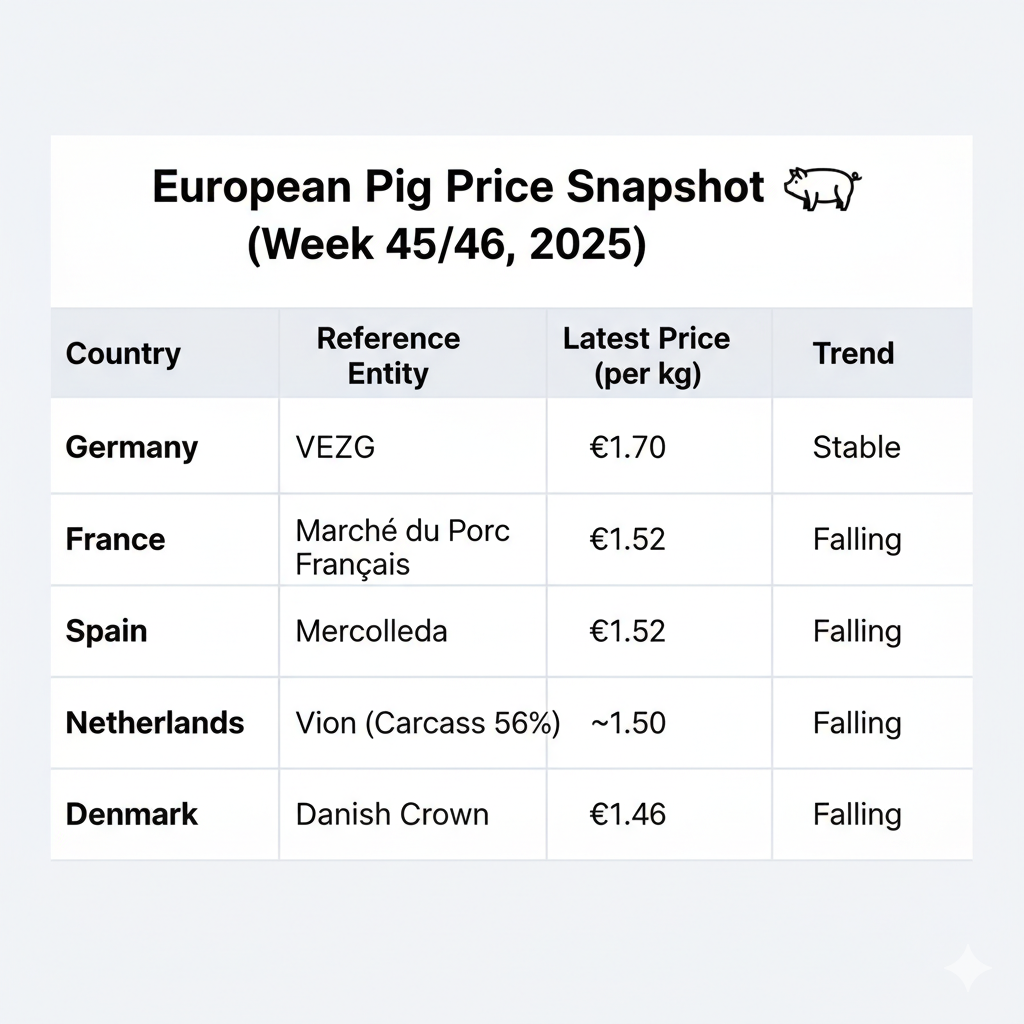
Published in Market Analysis
Market Pulse: Europe's Great Pork Price Divide
Chinese tariffs flood the EU with surplus pork, but a national shortage in Germany is holding prices high... for now.

A significant fracture is running through the European "standard pig" market this November. While German producers are holding prices firm at a high of €1.70/kg, major exporting nations like Spain, France, and Denmark have seen their reference prices cluster at a much lower level, between €1.46/kg and €1.52/kg.
This isn't a simple market variation; it's a "two-speed" Europe, driven by a perfect storm of an export crisis, national supply shortages, and the very mechanics of how each country sets its price.
Here is a breakdown of the latest reference prices and the powerful forces behind them.

Analysis: Three Forces Driving the Divide
1. The Main Event: The Chinese Export Crisis
The single biggest driver for the low prices in Spain, Denmark, and the Netherlands is the collapse of the Chinese export market.
The Shock: In September 2025, China imposed retaliatory anti-dumping tariffs of up to 62.4% on EU pork products.
The Impact: This has been catastrophic for Europe's top exporters. Spain, the Netherlands, and Denmark, which previously sent a massive volume of pork (especially offal products) to China, have lost their most valuable non-EU market overnight.
The Result: A massive surplus of pork is now backing up in Europe. This meat, with nowhere else to go, is flooding the internal EU market, causing prices in these export-heavy nations to plummet.
2. The German "Island": A National Supply Shortage
So, why is Germany's price holding 20 cents higher than its neighbours? Because it is facing the opposite problem.
Shrinking Herd: Germany's pig herd has been in structural decline for years.
FMD Outbreak: The Foot and Mouth Disease (FMD) outbreak in Brandenburg earlier in 2025 (though now contained) further tightened the domestic supply of slaughter-ready pigs.
The Result: The German producer association (VEZG) is basing its €1.70 recommendation on its own national reality: a low supply of pigs and high demand from domestic processors.
3. How Prices Are Set (And How Fast They Fall)
The price gap is also a story of who sets the price and how fast they can react.
Processor-Led (Denmark & Netherlands): In these countries, major processors like Danish Crown and Vion set the weekly quotation. When the Chinese tariffs hit, they reacted instantly by slashing their payment prices.
Market-Led (Spain & France): At Spain's Mercolleida and the Marché du Porc Français, prices are set in a negotiation. With the export market gone, buyers simply refused to pay high prices, and the market-clearing price collapsed.
Producer-Led (Germany): The VEZG is an association of farmers. Their €1.70 price is a recommendation, creating the central conflict of the entire EU market.
Market Outlook: An Unstable Standoff
The European pig market is now in a state of high tension. The key question is: How long can the high-price "island" of Germany hold out against the sea of cheap imports?
German processors are under immense pressure to import cheaper pork from Denmark and Spain rather than buy domestic pigs at €1.70. This surplus is weighing heavily on the entire EU, and the downward pressure is immense.
A Digital Solution for a Disconnected Market
The current standoff highlights a major inefficiency in the European market: a surplus of pork in one region cannot efficiently find its way to buyers in another.
This is where a centralised digital marketplace like Meat Borsa can play a critical role.
Real-Time Price Discovery: Instead of relying on weekly national quotations, buyers and sellers could see live bid/ask prices from across the EU. This would help find the true market-clearing price between the German €1.70 and the Spanish €1.52.
Immediate Market Access: A Spanish producer with a surplus could instantly list their volume, making it visible to thousands of potential buyers in Germany, Poland, or Italy, not just their existing contacts.
Clearing the Surplus: Meat Borsa would act as a hub to efficiently move the surplus pork from export-blocked nations to supply-tight nations, easing the downward pressure in Spain and filling the supply gap in Germany.
Transparency & Data: By connecting the fragmented markets, the platform would create a single, transparent view of European supply and demand, helping the entire industry avoid such extreme volatility.
Sources
Germany: VEZG (Vereinigung der Erzeugergemeinschaften für Vieh und Fleisch)
https://www.vezg.de/preisinfo-schweine.html
Spain: Mercolleida (Lonja de los mercados agrícolas y ganaderos)
https://www.mercolleida.com/en/
France: Marché du Porc Français
https://www.marche-porc-francais.com/
Denmark: Danish Crown (Producer Prices)
Netherlands: Vion Food Group (Pig Farmer Quotations)
Market News: Agricultural & financial news reports (September-October 2025) on Chinese anti-dumping tariffs on EU pork and reports from the Swine Health Information Center (SHIC) on the 2025 FMD outbreak in Germany.
